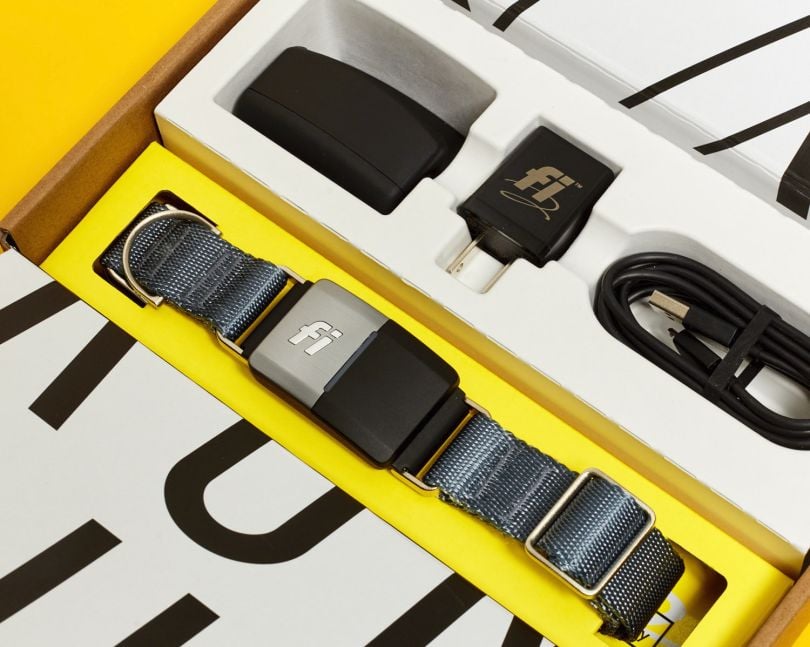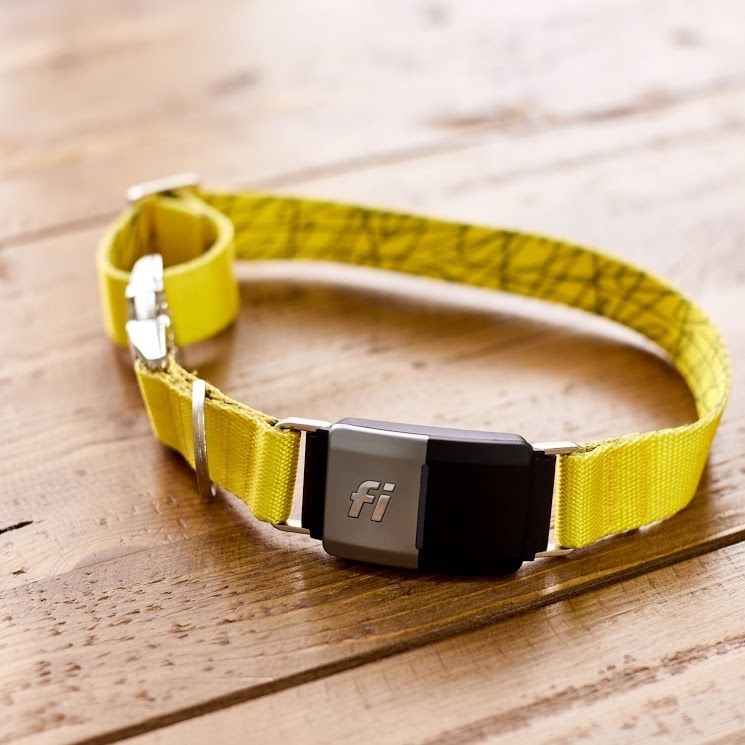Designing for dogs is no walk in the park.
Just ask Fi, a New York-based maker of a smart collar that allows dog owners to track their dogs’ steps, set parameters for where their pups can wander and even get notified when their dogs stray.
Since launching in March, the water- and chew-proof collar has sold “tens of thousands” of units, according to founder Jonathan Bensamoun, and Fi’s engineers say it’s the first wearable to take advantage of a recently-launched, low power wide energy cellular network.
“This product needs to live around the neck of a dog, and so there are a lot of mechanical constraints there.”
Working with brand-new technology is a challenge in and of itself — but the company’s engineering team also had to make the collar comfortable for dogs to wear and ready to withstand pretty much anything.
“This product needs to live around the neck of a dog, and so there are a lot of mechanical constraints there,” Bensamoun said. “Like the dog could chew on it, the dog could play in the mud with it, and it has to be waterproof because a dog could play in a pool and then jump in the ocean waters.”
We asked Bensamoun and Bob Blake, who heads up Fi’s hardware operation, about how they put it together, and for their advice to others looking to enter the world of wearables.
-
Start by prioritizing the most important feature. Fi’s creators figured that people would care about long battery life, and that this would help separate their product in the market.
-
When working with new technology, make sure to test young product manufacturers’ claims. When Fi looked for a cellular radio manufacturer to connect to the LTE-M network, many vendors they surveyed did not have a good gauge of their products’ abilities, since the products had never been used to create a wearable device before.
-
Don’t forget to design for your end user. Engineers knew that a slim collar would be most comfortable for dogs. They layered the circuit board and designed Fi’s antennas so they took up as little space as possible, without compromising the product.

For wearables, battery life is a careful balancing act
Early on, Fi’s engineers decided to focus on ensuring a long battery life for the collar. In their view, battery life was a major pain point for similar devices, and it would offer a meaningful improvement over existing items on the market. The company claims one charge can keep Fi going for up to three months.
The solution they came up with was connecting to a low-energy cellular network, called LTE-M, often used for industrial sensors, smart buildings, and water and gas metering. By connecting to the LTE-M network, Bensamoun said Fi’s radio waves are able to travel further away from the cell tower, pass through structures more easily and track dogs underground, because the receivers are more sensitive to longer wavelengths on the primary frequency band.
The main benefit of operating on this network, however, is that Fi is able to burn less battery power than it would if it were connected to 3G or LTE, which are networks designed primarily with cell phone use in mind. Cell phones need to constantly communicate with the nearest cell tower to make sure they are always available to make and receive calls, Bensamoun said.
“Your cell phone basically needs to consistently communicate with the closest cell tower and say, ‘I'm alive, I'm alive.’ If it doesn't do that, the cell tower is going to forget the phone from the network pretty fast,” Bensamoun said.
By leveraging LTE-M, Bensamoun said devices are able to “go to sleep” for a certain amount of time — or take a break from constantly calling up the cell tower — which saves battery life. Antennas and an accelerometer embedded in Fi automatically communicate to the cell tower to let it know when the dog needs to be tracked.
“You’re going to have a lot of times where you don’t need to actively track the dog, so you don’t need that connectivity to the network.”
“You’re going to have a lot of times where you don’t need to actively track the dog, so you don’t need that connectivity to the network,” Bensamoun said. “So it’s very important to have a protocol that supports these periods, where you can be in a very low power mode — a dormant stage — and that’s what LTE-M creates.”
Fi operates on two modes already implemented on the LTE-M network to save battery power: power save mode and extended discontinuous reception. By utilizing power save mode, the collar automatically turns off monitoring of paging instances in the device and increases the amount of time between periodic tracking area updates, which are used to inform the nearest cell network of the device’s existence and registration. Extended discontinuous reception momentarily switches off the receiver section of the collar’s radio module, adding to the amount of time the device is not listening to the network.
Bensamoun said Fi implemented a failsafe to make sure that, if a dog runs away but is resting, users will still be able to use the collar to track the dog.
“There was a lot of trial and error in different geographic areas,” he said. “We also used simulators to mimic extreme conditions to make sure that the collar would react properly.”

When working with new technologies, you need to test early and often
Connecting to the LTE-M network meant that Fi needed to find a cellular radio manufacturer operating in the young field. But finding a vendor that delivered proved difficult, according to Bob Blake, vice president of hardware and operations. The technology was so new that, in some cases, even the providers didn’t have a good read for how long their devices could last before needing to connect to a cell tower — which, of course, impacted battery life.
“Once you start testing, you realize what the actual upsides and downsides are.”
“You start testing them out and you realize that the documentation that you’re seeing doesn’t match the actual performance that you’re getting,” Blake said. “Even though they look good on paper, once you start testing, you realize what the actual upsides and downsides are.”
Blake said there also were unexpected software bugs that popped up in the development process — small items that development firms missed because, again, they just hadn’t spent time on a public network. During the development process, Fi switched providers a few times before settling on their current cellular radio vendor, which Blake declined to name.

Packing it all in is ‘a lot like solving a puzzle’
When engineers started brainstorming all the components a smart dog collar would require, their initial sketches left them with a product the size of an iPhone. Understanding that comfort for a dog was at least partially dependent on the size of the collar, engineers worked to shave millimeters off the device by densely packing its cellular radio circuit board and manipulating the design of its antennas. Fi’s tracking device is now about 15 millimeters thick.
“We set the industrial design constraints from the get-go,” Blake said. “You have to say, ‘It can’t be any thicker than this. Make it work within these constraints.’”
Fi’s cellular radio is comprised of three custom antennas — one for the Bluetooth, one for the GPS and one that connects to the cell towers — a circuit board, and a lithium ion battery.
An internal antenna development team built the antennas, which they modeled after those that are in cell phones. AT&T mandates minimum performance standards for these antennas, and they work best when there’s space between them and the circuit board — a problem when engineers are working to snip at the size of the device.
“Antenna engineering is a complex subject. People liken it to black magic.”
“Antenna engineering is a complex subject. People liken it to black magic,” Blake said. “At a certain point, our antenna development team was basically like, ‘We’re not gonna be able to make this work. We need at least a millimeter more space.’”
Engineers manipulated the physical composition of the antennas to cut their size. Antennas are comprised of metal traces deposited onto plastic carriers in “tightly controlled patterns, so that they resonate at all the right frequencies and perform as efficiently as they need to,” Blake said. By tweaking the size and type of copper traces deposited onto the plastic carriers, engineers were able to squeeze as much separation as possible between the antenna and the circuit board. They also layered the circuit board’s components, rather than letting them stretch into one long line.
“It truly is a lot like solving a puzzle,” Blake said. “You’re trying to take all these little components in different shapes and sizes and make sure that all the connections are made between them in the most efficient routing possible, while you’re getting them all as close together as possible.”

How to design for dogs
Bensamoun originally designed Fi with his German Shepherd in mind — he had a hunch that his dog walker wasn’t exercising Thor for the full hour promised.
His insight into his dog’s favorite activities informed the connected collar’s design. Fi’s battery pack is encased in metal, so pups can’t chew through it. Engineers subjected the collar to the IP68 water resistant test, which means they held it under 1.5 meters of water for 30 minutes and the collar still works. Bensamoun said the radio waves emitted from the device also meet international safety guidelines.
“The level of radio emissions of the collar was like a thousand times less than your iPhone in your pocket being two feet away from the dog,” he said.




